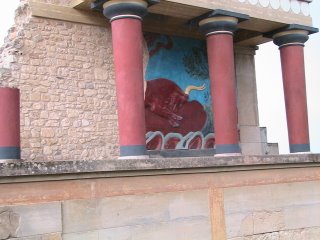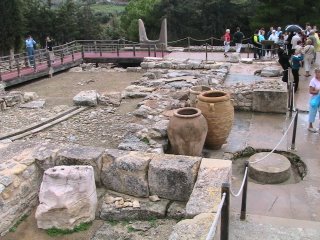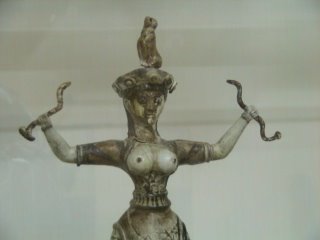Knossos

Perhaps Knossos is the real birthplace of civilization, religion, philosophy, agriculture and human social order. This is the ancient land of the fabled Labyrinth and the home of the mythical Minotaur.

Knossos appears to have been a working city of some 22,000 square meters and was triving during the Neolithic Period, some 6,000 years B.C. It was the heart of the Minoan civilization and perhaps the model from which the great mysteries of Egypt and Greece were later developed.

We visited it on a rainy and windy day, our third day in Crete. and were thrilled by its mystery and wondered if its real message has yet been found.
Like most people, I have always wished I had become an archeologist - never having been involved such a thing before, it

looks wonderful, fascinating, delightful. At any rate, Knossos is a site long in process of evacuation, and it will be for a long time to come.
There is a museum on the edge of the grounds which has some of the artifacts and a number of replicias.
 The Snake Lady is much more than a topless gal with a couple of snakes and a cat on her head. Her name was Potnia, and she may have been the one for whom the entire island of Crete was named. Women ruled this civilization and were the leaders of the people. The word Crete comes from the Greek “Ruling Goddess”, and the Snake Lady was apparently the feminine of Poseiden who much later became sort of the “patron god” of Crete.
The Snake Lady is much more than a topless gal with a couple of snakes and a cat on her head. Her name was Potnia, and she may have been the one for whom the entire island of Crete was named. Women ruled this civilization and were the leaders of the people. The word Crete comes from the Greek “Ruling Goddess”, and the Snake Lady was apparently the feminine of Poseiden who much later became sort of the “patron god” of Crete. Zeus himself was born on Crete and grew up here, probably right here at Knossos. Zeus and the Phoenician princess Europa
 had a child, known as Minos, and Zeus installed him as the King of Crete.
had a child, known as Minos, and Zeus installed him as the King of Crete. When the people revolted, Poseidon sent a bull that walked up out of the sea for Minos to sacrifice to prove that he (Minos) was indeed chosen as king by the gods. But Poseidon’s bull was so beautiful that Minos kept it and sacrificed one of his own bulls. Poseidon was neither fooled nor amused by this and he made King Minos’s wife fall in love with the beautiful bull and eventually she bore the bull’s child - a creature that was half man and half bull - the Minotaur! Well the Minotaur was then put in a labyrinth built to contain him, and from which no one could ever escape - until Dadedalus and his son Icarus made their great flight out of the Labyrinth, wherin Icarus got so close to the sun that the heat melted his wings of wax and he fell into the Icarean Sea. Finally, Ariadne brought her thread and magical sword to Thesus and then - well, you shouldn’t expect an American to be able to explain
 anything this complicated, especially a mere man, so you really ought to go to Knossos and see all this for yourself.
anything this complicated, especially a mere man, so you really ought to go to Knossos and see all this for yourself. Perhaps the entire story of Crete and maybe even the mystery of life itself is contained here in this secret plate called the Phaestos. No one has yet interpreted it.
2006.1014
© John Womack, 2006. All rights reserved
Photos made with Canon Elura 70 using SD card.

0 Comments:
Post a Comment
Subscribe to Post Comments [Atom]
<< Home